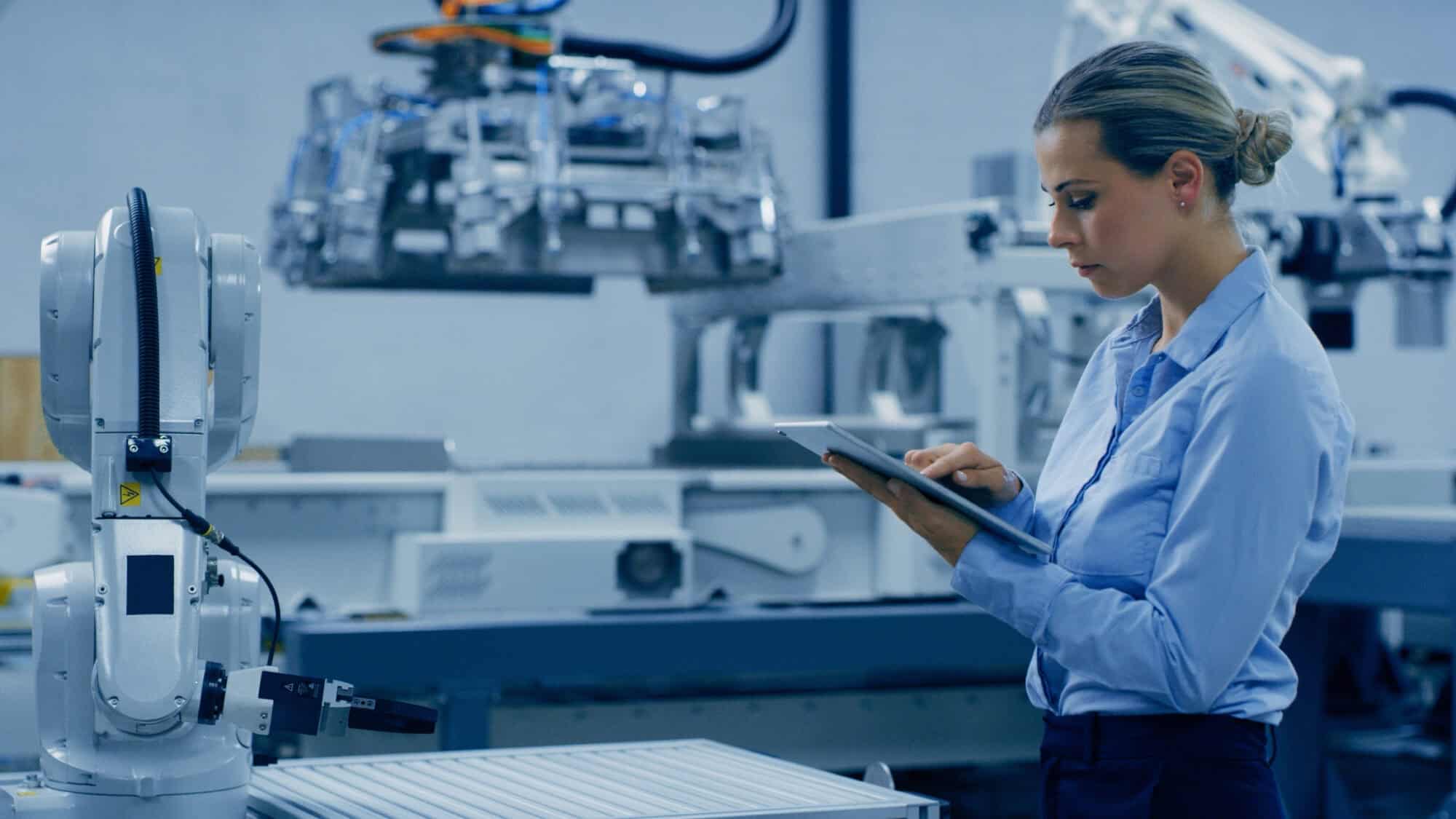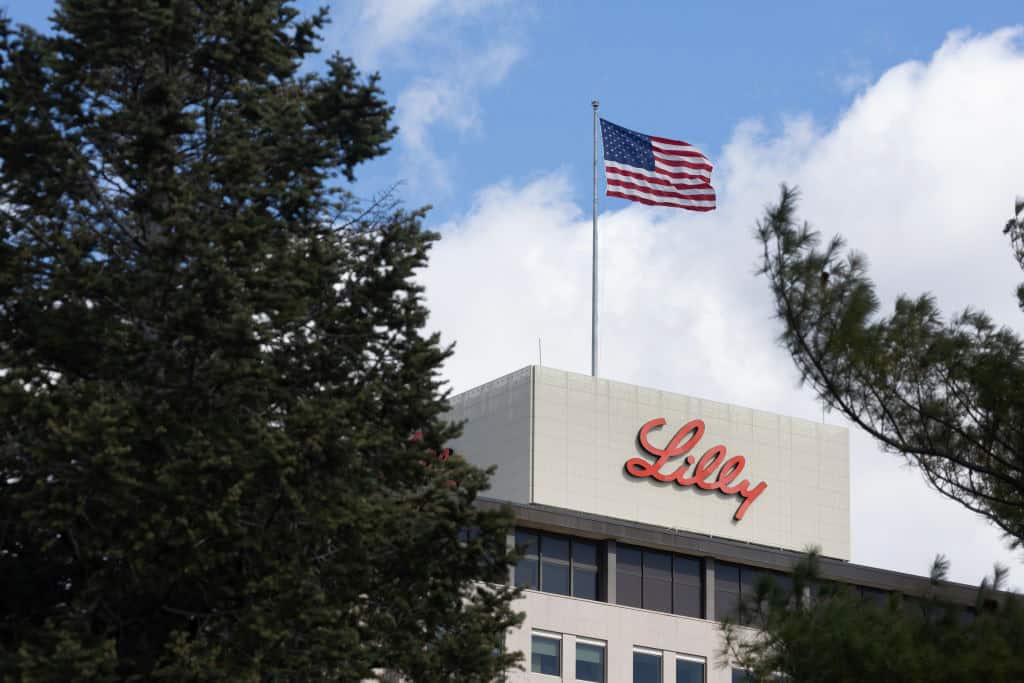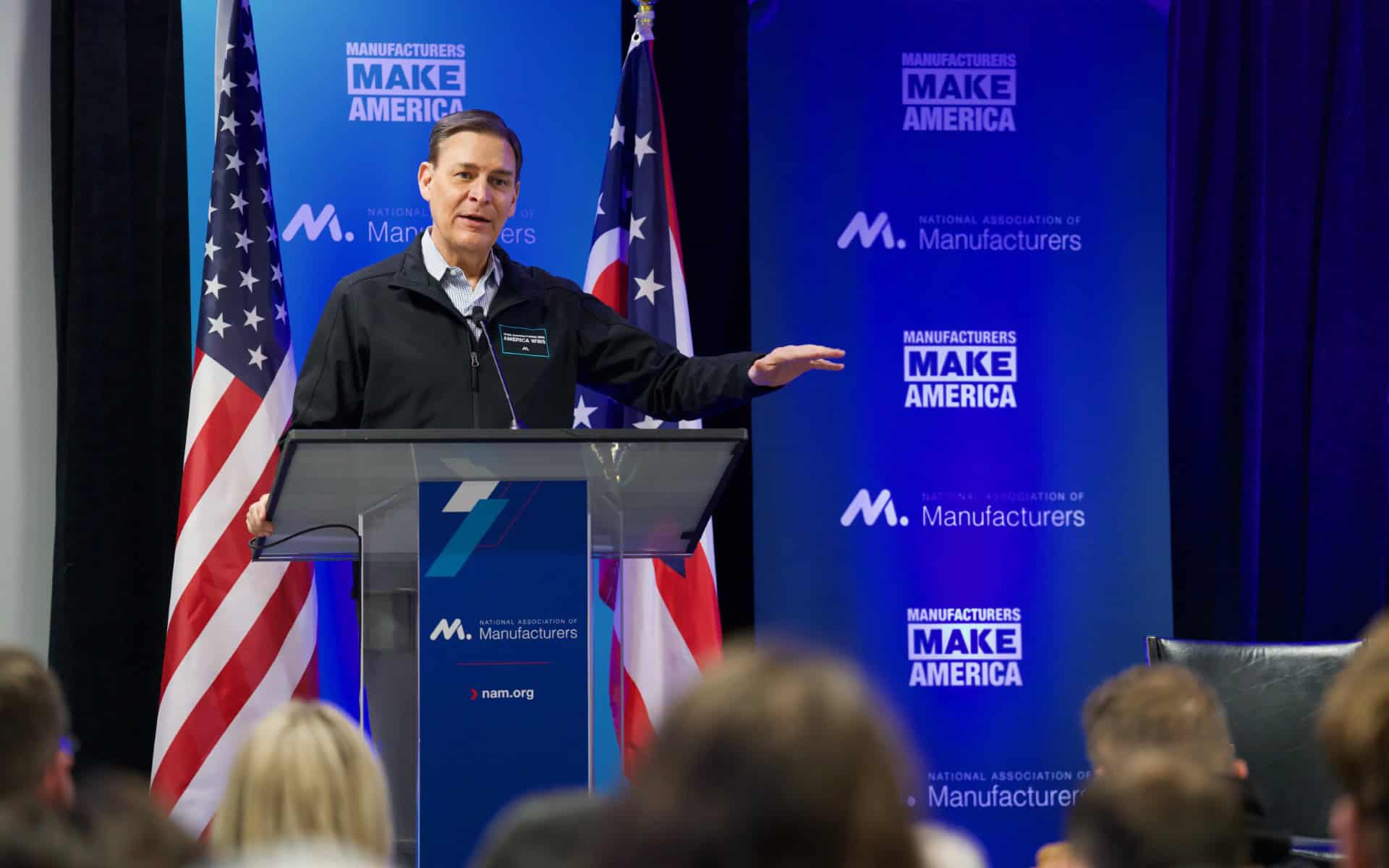Light-Touch AI Regulation Serves Manufacturers, Consumers Best

Artificial intelligence has become integral to modern manufacturing, which is why manufacturers support the Trump administration’s goal of making America globally dominant in AI, the NAM told the White House this month.
What’s going on: “[M]anufacturers use AI in myriad ways, which has made AI integral to modern manufacturing and put manufacturers at the forefront of developing and implementing AI systems,” the NAM told White House Office of Science and Technology Policy Acting Director Michael Kratsios and AI and Crypto Czar David Sacks last Friday in response to a request for information on the development of an AI action plan.
- The NAM supports President Trump’s stated goal of “sustain[ing] and enhance[ing] America’s global AI dominance in order to promote human flourishing, economic competitiveness and national security” while also, in Vice President Vance’s words, “avoid[ing] an overly precautionary regulatory regime.”
- The NAM has been one of the foremost voices for smart regulations on AI. Last May, it published “Working Smarter: How Manufacturers Are Using Artificial Intelligence,” a first-of-its-kind AI report on AI deployment in manufacturing and an accompanying list of suggested AI-policy actions Congress and the administration should take.
What should be done: To ensure that Americans benefit from AI safely and in a manner that does not unduly hamstring innovation, four specific steps should be taken, the NAM said:
- Direct regulators to update their frameworks for the AI age: “[M]anufacturers recommend that the AI Action Plan direct federal regulators to review the statutory and regulatory frameworks they maintain and enforce”;
- Customize AI regulations: “AI is context-specific, so ‘AI regulation’ should be too”;
- Transparency between AI vendors and users: The plan should direct [the National Institute of Standards and Technology] to work with the industry to develop best practices on how vendors explain how they develop and train their AI systems, to help companies defend their use of these AI systems in front of regulators.
- “Right-size” compliance burdens: “The ubiquitous use of AI throughout modern manufacturing, as well as manufacturing’s dependence on innovation, underscore the need for rules that enable rather than hinder manufacturers’ development and adoption of AI systems.”
Other critical needs: In addition, the NAM urges the administration to prioritize the following as part of its AI action plan:
- A “dual workforce strategy”: “The AI Action plan should make enhanced access to, and support for the development of, science, technology, engineering and mathematics (STEM) education programs throughout the country, at both the K-12 and higher education levels, a national priority … and increas[e] the allowable number of advanced degree STEM graduates for employment-based visa categories, in particular among lawful permanent residents.”
- Permitting reform and existing energy generation: The plan should endorse expedited judicial review and permitting processes for energy generation projects, working “with stakeholders to identify ways that the projected increase in demand growth can be leveraged to lower the cost curve of traditional light-water [nuclear] reactors” and look closely at the role of natural gas as a source of baseload power for the data center sector.
- Privacy and security: Work “with Congress to pass a national privacy law that fully preempts the growing patchwork of state laws, protects individuals’ privacy and provides much needed legal clarity to support continued innovation and competitiveness.”
New House AI, Energy Working Group Issues RFI

The newly established House of Representatives’ AI and Energy Working Group is seeking information on the increase in energy demand we can expect due to the growing use of artificial intelligence (POLITICO Pro, subscription).
What’s going on: Group lead Rep. Julie Fedorchak (R-ND)—who was North Dakota’s head utility regulator for more than a decade prior to being elected to Congress last year—discussed the new working group with us Tuesday at NAM headquarters.
- Rep. Fedorchak spoke at an event at the NAM on how the U.S. can strengthen the electrical grid, advance permitting reform and support manufacturers investing in the latest energy technologies.
- The working group issued a request for information on Monday, “invit[ing] stakeholders to provide written responses” to questions under “three pillars,” according to the RFI document.
The details: These pillars are the following:
- American Energy Dominance and AI Energy Demands: The RFI “seeks to identify strategies to secure a stable, affordable and sustainable domestic energy supply capable of powering next-generation AI infrastructure.” Subtopics on which respondents are asked to inform the working group include oil and gas, nuclear, solar, geothermal and other power production methods.
- Securing the Energy Grid: A resilient, secure electrical grid is “essential” for AI systems and the larger “digital economy,” the document says. Permitting reform, electricity generation and baseload power are possible subtopics here.
- Strategic Competition: Outpacing China: “In an era of intensifying global rivalry, ensuring American technological and energy leadership is critical.” Some of the subtopics under this pillar are manufacturing, critical minerals and chips.
Why it’s important: “To be AI dominant, we must first be energy dominant,” Rep. Fedorchak said in a statement, according to POLITICO Pro.
- “In 2024, data centers accounted for 4.3% of total U.S. power demand, and analysts predict this could climb to as much as 12% by 2030—more electricity than the entire state of Texas uses today. Yet the U.S. isn’t scaling up reliable baseload power quickly enough to support this rapid growth.”
How to respond: Responses are due by May 15 and should be emailed to [email protected].
Rethink 2025 Is Coming Up Fast

Get ready! Manufacturing’s leading annual event on accelerating digital transformation is right around the corner.
What’s going on: Rethink—held by the Manufacturing Leadership Council on Marco Island, Florida, each June—is a must-attend conference for anyone interested in Manufacturing 4.0 and where it’s headed (The MLC is the digital transformation division of the NAM.)
- This year’s event takes place June 15–18 at the JW Marriott Marco Island Beach Resort.
Why you should go: Rethink attendees will get an inside look at the cutting-edge processes and technologies transforming manufacturing today—directly from those creating and implementing them. They’ll also get a chance to:
- Consult with peers on manufacturing’s most critical initiatives, including smart factories and digital production, resilient supply networks and analytics and data mastery;
- Participate in real-time discussions and one-on-one meetings to help them understand how various solutions can solve their business problems;
- Hear from industry leaders and experts during panel discussions, executive interviews and more;
- Interact and collaborate with peers during interactive “think tank” sessions; and
- Hear from the MLC’s event partners during Rethink’s exclusive VIP Tour.
Who will be there: Scheduled speakers include Siemens USA President and CEO Barbara Humpton, Eaton Vice President of Industry 4.0 Craig Sutton, Hershey Company Vice President of Manufacturing, Operations Technology and Supply Chain Strategy Will Bonifant, Rockwell Automation Senior Vice President of Intelligent Devices Tessa Myers and many more.
The gala: Closing out the packed three-day event is the Manufacturing Leadership Awards Gala, at which the MLC will recognize award finalists and winners of the Future of Manufacturing Award, the Manufacturing Leader of the Year, the Small/Medium Enterprise Manufacturer of the Year and the Large Enterprise Manufacturer of the Year. The gala will take place on the evening of June 18.
Attend: Register online here for Rethink 2025. (NAM members get a discount at checkout.) Questions? Send them to [email protected].
Survey: Trade Policies Shake Up Manufacturers’ Economic Outlook

Manufacturers are increasingly worried about the future of trade and rising raw material costs, according to the Q1 2025 NAM Manufacturers’ Outlook Survey.
What’s going on: In the most recent survey, conducted from Feb. 11 to Feb. 28, trade uncertainties moved to the top of the list of manufacturers’ concerns—with 76.2% of respondents citing them as their primary worry. Increased raw material costs came in second, cited by 62.3% of those surveyed.
- In fact, manufacturers expect prices on their companies’ product lines to go up by 3.6% in the next year, an increase from 2.3% in Q4 2024 and the highest since Q3 2022, when inflation was more than 8%.
- Manufacturers also anticipate the cost of raw materials and other inputs to rise 5.5% in the next year, the highest expected rate of increase since Q2 2022, when inflation was between 8% and 9%.
- Manufacturers foresee export sales to increase just 0.1% in the next year. That’s the lowest anticipated rise since Q2 2020 at the height of the COVID-19 pandemic.
- In addition, the percentage of manufacturers with a positive outlook for their company inched down from the last quarter, to 69.7% from 70.9%.
Taxes: Manufacturers also feel strongly that their businesses need the “rocket fuel” of the tax reform extension. If Congress fails to extend pro-manufacturing provisions of the Tax Cuts and Jobs Act of 2017:
- 69.35% of respondents said they would delay capital equipment purchases;
- 45.23% would delay hiring;
- 44.72% would pause operations expansions;
- 41.71% would limit R&D investment; and
- 40.20% would curb employee wages or benefits increases.
Our take: “The pressure of increased costs, trade instability and sluggish demand is dampening the sector’s momentum, making it more difficult for manufacturers to plan, invest and hire,” NAM President and CEO Jay Timmons wrote in a social post Thursday.
- “We are calling for a comprehensive manufacturing strategy that includes a commonsense trade policy in addition to making President Trump’s 2017 tax reforms permanent and more competitive, securing regulatory certainty, expediting permitting reform to unleash American energy dominance and key manufacturing projects and increasing the talent pool.”
Women MAKE Awards to Honor Outstanding Women in Manufacturing

The Manufacturing Institute—the workforce development and education affiliate of the NAM—has announced the recipients of the 2025 Women MAKE Awards, honoring some of the most impressive and inspiring women in the manufacturing industry today.
The awards, which will take place in Washington, D.C., on April 24, will highlight 130 individuals who have demonstrated excellence and leadership in their careers across all levels of the manufacturing industry.
The challenge: The manufacturing industry faces a significant talent gap—with more than 400,000 job openings and an estimated 3.8 million positions needing to be filled by 2033.
- Women make up about half of the U.S. labor force, but less than one-third of the manufacturing workforce. Boosting the numbers of women who choose a career in modern manufacturing is essential to closing this gap—and the honorees of the Women MAKE Awards are leading the way.
The initiative: The MI’s Women MAKE America Initiative strengthens the modern manufacturing workforce by elevating and highlighting the women leading the industry at every level—from the shop floor to the C-suite—in order to inspire the next generation and help close the talent gap in the industry.
The awards: Each year, 100 Honorees and 30 Emerging Leaders are chosen from the thousands of nominations submitted to the MI by their peers for making significant contributions to their companies, communities and efforts to cultivate the next generation of skilled talent. Since its inception, the Women MAKE Awards have recognized about 1,700 outstanding individuals.
The MI says: “Every year, more women are finding opportunity and breaking barriers in manufacturing,” said MI President and Executive Director Carolyn Lee. “By elevating these outstanding women for their success, we are showing young women—and everyone else—that manufacturing is a rewarding industry with unlimited potential.”
- “At a time when there is such high demand for talent in our sector, these extraordinary women demonstrate the impactful careers that are available. By elevating role models who are paying it forward, the Women MAKE Awards strengthen the future of the industry by inspiring the next generation.”
Manufacturing leaders say: “With hundreds of thousands of open jobs in manufacturing, it has never been more critical to attract and retain top talent,” said Toyota Senior Vice President of Electric Vehicle Supply Susan Elkington.
- “This year’s Women MAKE Honorees and Emerging Leaders are breaking barriers, leading with innovation and proving there is no limit to what they can achieve in our industry. By amplifying their stories and accomplishments, we inspire others to step into manufacturing and shape its future.”
Learn more: Read about the awardees and learn more about the awards gala.
Lilly: 2017 Tax Reform Makes Four New U.S. Manufacturing Sites Possible

Biopharmaceutical company Lilly will build four new manufacturing sites across the U.S., it announced Wednesday at a Washington, D.C., press conference. The event was attended by NAM President and CEO Jay Timmons, Commerce Secretary Howard Lutnick, National Economic Council Director Kevin Hassett, Indiana Sen. Todd Young and Lilly Executive Vice President and President of Manufacturing Operations (and NAM board member) Edgardo Hernandez, among others.
What’s going on: Three of the planned manufacturing campuses will focus on producing active pharmaceutical ingredients, reshoring “critical capabilities of small molecule synthesis and further strengthening Lilly’s supply chain,” the company said in a press release. The fourth site will “extend [Lilly’s] global parenteral manufacturing network for future injectable therapies.”
- The investment in the four sites will bring Lilly’s total U.S. capital expansion commitment to more than $50 billion since 2020.
- Lilly—which in recent years has made $23 billion worth of investments in new research and manufacturing sites in the American South and Midwest—is in talks with several states about building the facilities there, but it is accepting additional expressions of interest from states until March 12.
The anticipated benefit: The four sites are expected to create more than 3,000 permanent skilled jobs and more than 10,000 construction jobs during building, according to the company.
The tax reform factor: Lilly’s planned expansion reflects “decades of research and dedication,” Timmons said at the event announcing the investment. It “is the culmination of sustained planning made possible by the certainty created through smart public policy—particularly the 2017 tax reforms that President Trump … championed back at a meeting of the NAM Board of Directors in September 2017.”
- Many of those manufacturing-critical reforms have been allowed to expire, however, and others will expire at the end of the year—unless Congress acts, and soon, Lilly Chair and CEO David Ricks said.
- “The Tax Cuts and Jobs Act legislation passed in 2017 during President Trump’s first term in office has been foundational to Lilly’s domestic manufacturing investments, and it is essential that these policies are extended this year.”
Keep the momentum going: Lilly’s announcement shows other manufacturers “exactly why [they] have reason for optimism and confidence,” Timmons went on. “But to keep this momentum going—to encourage more groundbreaking investments, more job creation and more life-changing innovation—a comprehensive manufacturing strategy must become the reality … because when manufacturing wins, America wins.”
Trend of the Week: Enabling Innovation in Manufacturing

At the NAM, we’re examining some of the top trends that are shaping manufacturing this year, and offering the resources you need to take action.
Today, we’re taking a look at the industry’s efforts to enable innovation—and how manufacturers are working to stay on the cutting edge.
Applying technology: Digitalization can increase the speed and agility of innovations in areas like prototyping, iteration, simulation and modeling. And by using AI and data analytics to improve decision-making, manufacturers can build resilient, transparent supply chains that are more efficient and effective.
Upscaling workforces: Because of the rapid pace of technological advancement and adoption, manufacturers will have to create a workforce that is ready for the future—and processes designed to transfer knowledge and skills effectively and continuously.
Harnessing partnerships: Manufacturers can lean into collaborations that help to accelerate innovation. By connecting with manufacturing peers, government institutions and academia, industry leaders can develop unique and inventive paths forward.
Expert insight: According to CEO and Co-Founder of Narratize Katie Trauth Taylor, tools like generative artificial intelligence can accelerate and automate manufacturing innovation—with human ingenuity at the helm.
- “Human-led AI methodologies enhance teams’ ability to analyze opportunities, translate complex concepts into compelling business cases and think deeply about their innovative work,” said Taylor. “With reduced documentation and improved communications, product teams can reallocate their time value-generating work—deeper market research, sharper strategy and accelerated development.”
Resources for you: Want to dive deeper? Check out some additional resources from the NAM.
- Explore the Innovation Research Interchange, a division of the NAM that focuses on value creation and top-line growth through the management of innovation.
- Join one of the Manufacturing Leadership Council’s Plant Tours in person—or read summaries of past tours—to get an inside look at how other manufacturers have reshaped processes to advance their businesses.
The State of the Manufacturing Workforce in 2025

The NAM kept up a breakneck pace on the third day of its 2025 Competing to Win Tour, with the Manufacturing Institute delivering the first-ever State of the Manufacturing Workforce Address at Drake State Community and Technical College in Huntsville, Alabama, before an audience of students, faculty, manufacturers and local and state officials.
Opportunity—for all: Taking the stage to give the MI’s assessment of the manufacturing worker base in 2025, Carolyn Lee, president of the Manufacturing Institute, the NAM’s 501(c)3 workforce development and education affiliate, homed in on the theme of opportunity.
- “Manufacturing is not just about innovation and economic growth; it’s about opportunity. It’s about ensuring that every community, every aspiring maker, builder and creator—no matter their background—can have access to the skills, training and careers that will define the future.”
- But because the industry stands at a crossroads, part of that opportunity today is to help manufacturing maintain its momentum, Lee said, echoing a theme of NAM President and CEO Jay Timmons’ 2025 State of Manufacturing Address on Tuesday.
Finest hours ahead: Lee was joined at the event by Rep. Dale Strong (R-AL), who spoke about the strength of Alabama’s manufacturing sector.
- “I think we’ve proven here in Alabama, and North Alabama especially, advanced manufacturing is part of our DNA,” he said. “You look at the jobs that we’ve brought in the last 10 or 15 years. You start with GE Aviation, Polaris, Toyota Motor Manufacturing, Mazda Toyota. We’ve proven that the Alabama workforce has the ability. I think our finest hours are still ahead.”
A world-changing job: Timmons echoed that sentiment. “You’re stepping into one of the most important and innovative fields in the world,” he told the Drake State students.
- “The products, the materials, the technologies that you will help create, they won’t just be used in your hometown or even all across our country. They’re going to help change economies … They’re going to strengthen the very foundation of America’s security and prosperity.”
A shortfall: But manufacturing today faces an immense challenge, Lee told the crowd: “a structural workforce deficit.”
- “[I]f we don’t act boldly, the U.S. faces a shortfall of 1.9 million manufacturing workers by 2033; 3.8 million positions will open up, but nearly half could go unfilled. That’s not just a workforce issue—it’s an economic and national security issue.”
- That’s despite the average annual earnings—including pay and benefits—for a manufacturing employee coming in at more than $102,000.
- The dearth of workers in the sector is driven by both retirements and growth.
How to overcome it: “[W]e have to inspire more Americans to see themselves in manufacturing,” Lee said. “That starts early, with programs that spark curiosity and excitement for careers in our industry. And when I say early, I mean as young as 9 or 10 years old—because today’s 4th graders will graduate in 2033 and may be our future team members.”
- To this end, the MI partners each year with manufacturers on MFG Day, which kicks off a full month of events at which companies show young people, students and job seekers what a modern manufacturing career looks like.
- The MI, with the support of Honda, has also created a new interactive experience to interest youngsters in the industry: “Innovators Quest,” which combines elements of board games and popular fantasy and storytelling activities.
The FAME factor: Under the MI’s auspices, the Federation for Advanced Manufacturing Education USA, a workforce program started by Toyota in 2010 and entrusted to the MI in 2019, has grown considerably. (Drake State is home to one of the public–private partnership’s newest chapters.)
- FAME participants attend classes and earn while they learn in hands-on apprenticeships with manufacturers.
- The program—in which a participant can easily earn more than $30,000 over two years—has become “the gold standard for how employers, educators and communities should work together” on manufacturing workforce training, Lee said.
Other efforts: The MI helps manufacturers actively recruit groups often overlooked in manufacturing hiring initiatives: veterans, women and previously incarcerated individuals.
- The Heroes MAKE America program helps connect former members of the military with manufacturing jobs. Walmart provides crucial funding to the program; in 2022, it gave a six-figure grant to fund the development of a model that translates skills acquired in the military to ones recognized by manufacturing employers.
- The Women MAKE America Initiative is the nation’s premier program aimed at closing the gender gap in the sector.
- “The MI is helping manufacturers develop second chance hiring strategies, recognizing that talent is talent—and potential shouldn’t be wasted,” Lee said to the audience.
Working together: “As we look ahead, manufacturers, educators and policymakers must work together to strengthen our talent pipeline,” Lee and Drake State Community and Technical College President Dr. Patricia G. Sims wrote in a Thursday op-ed for the Alabama Political Reporter.
Manufacturing in Alabama: On Thursday afternoon, the NAM and MI contingent continued its manufacturing-facility tour, visiting Toyota Motor Manufacturing Alabama and Bruderer Machinery—both in Huntsville—and Milo’s Tea Company in Bessemer.
- “I plan on making my career here,” said Drew, a 2024 FAME graduate, during a discussion before a tour of the shop floor. Drew is now working as a maintenance team member at Toyota Alabama. The talk focused on how the FAME program prepared participants for a rewarding career in auto manufacturing. Toyota Alabama—2,400-plus team members strong—has created 10,000 jobs in the state.
- Lee visited Bruderer Machinery, a leading manufacturer of high-precision stamping presses that provides solutions for the automotive, aerospace and electronics industries. Bruderer is also a key supporter of the FAME apprenticeship model.
- Timmons and the rest of the NAM team finished the day at Milo’s Tea, the fastest-growing tea company in America. The family-owned business, founded by CEO Tricia Wallwork’s grandparents Milo and Bea Carlton, has won 40% of the refrigerated iced tea market share in the U.S. “This reminded me of my grandmother’s iced tea,” said Timmons. “You could see how special Milo’s is by just walking the shop floor and seeing the smiles and camaraderie.”
Timmons: Tax Reform Paramount for Manufacturing Growth

Manufacturers need an integrated, comprehensive strategy for expanding their sector, and a large part of that is preserving and bringing back tax reforms, NAM President and CEO Jay Timmons said on CNBC’s “The Exchange” Wednesday.
What’s going on: Timmons spoke to the news channel from a teacher workroom at the Energy Institute High School in Houston, Texas, a stop on the first leg of the NAM’s 2025 Competing to Win Tour. He told show host Kelly Evans that any plans to bolster manufacturing in the U.S. must “start with renewing those tax reforms from 2017.”
- “A smart strategy is going to involve reducing the cost of doing business for manufacturers here in the United States,” he said, praising Republican House leadership for being “able to move” forward a House budget bill “that’s going to set the framework for those tax rates to be set, hopefully, permanently in stone.”
- The 665-student Energy Institute High School, led by Principal Lori Lambropoulos, is the first high school in the U.S. dedicated to preparing students for careers in the energy industry.
What else is needed: Timmons echoed some of the major themes from the NAM State of Manufacturing Address, which he gave Tuesday in Ohio.
- “We also are looking at regulatory reform,” he told Evans. “We’re looking at expanding our energy dominance. We’re looking at workforce policy … and then, of course, we have to have a sensible trade policy as well.”
But back to taxes: Bringing back expired provisions from the 2017 Tax Cuts and Jobs Act, and making them and other, scheduled-to-expire provisions from the legislation permanent, is critical to manufacturing’s future success, Timmons continued.
- “Ninety percent of my 14,000 members are small and medium manufacturers. Most of them benefit from the pass-through deduction that expires this year. And I don’t think what you want to see is a huge tax increase that will cost 6 million jobs in the economy happen if we don’t renew those reforms,” he said, citing data from a recent NAM study on the effects of a congressional failure to act on tax reforms.
- “That’s why the Speaker’s actions in the last day or so have been so incredibly important to get this thing moving forward. President Trump actually endorsed that bill—the ‘one big, beautiful bill,’ as he calls it—and that will help make America great again for manufacturing.”
Energy dominance: Also critical to the success of manufacturing and the U.S. economy as a whole: the right energy policies, Timmons said. Promising to “unleash the energy sector,” President Trump lifted the previous administration’s ban on liquefied natural gas exports on his first day in office.
- Yesterday, the NAM got to see first-hand some of the effects of that kept promise, when the team visited Freeport LNG’s liquefaction facilities near Houston.
- More than 9,000 construction jobs were created during the construction of those facilities, which now directly employ about 400 people. Their operations have an estimated total positive economic impact on the U.S. economy of more than $5 billion a year.
- “Energy is … a critical national security component,” Timmons said on CNBC.
Emphasis point: The tour also stopped at Bray International, a global leader in flow control and automation solutions, supporting U.S. energy dominance, LNG exports and high-tech manufacturing.
- The visit helped underscore why policies that support manufacturing investment and provide certainty to manufacturers are essential to America’s economic future.
Up next: Today, the NAM is in Alabama, where this morning Manufacturing Institute President and Executive Director Carolyn Lee gave the Manufacturing Institute’s State of the U.S. Manufacturing Workforce Address at Drake State Community & Technical College in Huntsville. (The MI is the NAM’s 501(c)3 workforce development and education affiliate.) The theme: building the workforce of the future.
- This afternoon, the team will tour Toyota Motor Manufacturing Alabama in Huntsville, the manufacturing facilities of Bruderer Machinery in Huntsville and Milo’s Tea Company in Bessemer.
State of Manufacturing 2025: When Manufacturing Wins, America Wins

“Manufacturing in the U.S. has momentum”—and to keep it going, manufacturers will need to push, NAM President and CEO Jay Timmons said Tuesday in the NAM’s annual State of Manufacturing Address.
What’s going on: Speaking to an audience of manufacturers and congressional and state officials at Armstrong World Industries in Hilliard, Ohio, Timmons, who was joined by NAM Board Chair and Johnson & Johnson Executive Vice President and Chief Technical Operations & Risk Officer Kathy Wengel, emphasized the “defining moment” for the industry and said that for manufacturing, “what happens next really matters.”
- “Uncertainty is the enemy of investment,” he told the crowd. “Manufacturing is a capital-intensive industry. We make decisions months and years in advance. … That’s why we need certainty. We need a clear, actionable, multistep strategy from our government—one that says, ‘We want you to invest here, hire here and succeed here.’”
- Timmons’ annual speech kicked off the NAM’s 2025 Competing to Win Tour, starting with a whirlwind four-states-in-four-days tour of manufacturing facilities, schools, government offices and more.
- “In Ohio, manufacturers have thrived because our leaders have taken decisive actions to keep our industry competitive,” Ohio Manufacturers’ Association President Ryan Augsburger said at the kickoff event. But now, “manufacturers across Ohio and the nation are facing critical challenges, from tax uncertainty, project delays and workforce shortages to supply chain vulnerabilities and price pressures that threaten our ability to grow. … These issues cannot wait.”
What manufacturing needs: Certainty from the federal government should come in several forms, Timmons said, including the following:
- Preserving tax reform: The 2017 tax reforms were “rocket fuel” for manufacturing in America—but key provisions have expired and others are scheduled to sunset. Congress must bring them back and improve and extend the package. “Every day that Congress delays because of process and politics, manufacturers face rising uncertainty, delayed investments and fewer jobs,” said Timmons.
- Regulatory clarity and consistency: Manufacturers today spend a total of $350 billion just to comply with regulations. “Commonsense regulation is critical to American manufacturers to continue to innovate, to compete against foreign manufacturers and to improve the lives of American citizens,” Austin So, general counsel, head of government relations and chief sustainability officer for Armstrong World Industries, told the crowd.
- Permitting reform: President Trump’s lifting of the liquefied natural gas export permit ban was a start, but to reach our full potential as energy leader, we must require “federal agencies to make faster decisions and reduc[e] baseless litigation,” said Timmons.
- Energy dominance: “America should be the undisputed leader in energy production and innovation. But … we are seeing opportunities for energy dominance fade in the face of a permitting process that takes 80% longer than other major, developed nations,” Timmons said, adding that we must cut red tape, require federal agencies to make faster decisions and reduce meritless litigation.
- Workforce strategy: By 2033, manufacturing faces a shortfall of 1.9 million manufacturing employees, Timmons said. To fill those positions, the sector needs a “real workforce strategy,” one that includes apprenticeships, training programs and public–private partnerships.
- Commonsense trade policy: If President Trump continues to use tariffs, “we need a commonsense policy … that provides manufacturers with the certainty to invest” and “a clear runway to adjust,” according to Timmons.
State of manufacturing: “Manufacturing in the United States is moving forward,” Timmons said. “Like a press at full speed, like a production line firing on all cylinders, like the workers who show up before dawn and leave long after the job is done—manufacturing in the United States is driving us forward.” And Timmons added that now it’s time “to make America Great for Manufacturing Again.”
On the move: Following the speech, Timmons, Wengel and Augsburger joined state lawmakers, including state Sens. Kristina Roegner and Andrew Brenner, and local business leaders for a visit to the Ohio Statehouse for an event focused on the importance of tax reform for Ohio and its manufacturing sector.
- A recent NAM study found that, if key provisions of tax reform are allowed to expire, Ohio would risk losing 208,000 jobs and $18.9 billion in wages.
What’s at stake: Tax reform was transformational for Humtown Products, the Columbiana, Ohio–based family-owned sand cores and molds manufacturer, President and CEO Mark Lamoncha told the audience at the Ohio Statehouse tax event.
- “We have been at the forefront of 3D-printed manufacturing for years and have invested significantly in the machinery and equipment required, including the purchase of 3D printers—one of which can easily cost over $1 million,” he said.
- “Since the 2017 tax reform, Humtown has invested over $9 million in capital expenditures related to 3D printing and averages around $100,000 annually in R&D costs. Under the 2017 tax reform, we were able to deduct 100% of those costs, generating around $1.6 million in accelerated tax savings.”
- “That amount alone allowed us to purchase another 3D printer, fueling continued growth. That’s what tax certainty allowed us to do. But right now, that certainty is slipping away. As these provisions begin to expire, our tax burden is increasing.”
Creators Wanted: The group also fit in a stop at Columbus State Community College, which serves approximately 41,000 students, to visit with students in the semiconductor and mechanical drive classes.
The last word: The NAM recently “stood shoulder-to-shoulder with congressional leaders—delivering a clear, urgent message on tax reform” and is “driving the agenda on regulatory certainty, on energy dominance, on permitting reform, health care and workforce development,” Wengel told the audience. “The NAM is not waiting for Washington to act; we are making sure Washington acts for you, for manufacturers.”
- Added NAM Executive Vice President Erin Streeter: “The NAM is on [these issues], and we’re going to keep fighting, as we do every day with the right leaders, the right strategies and the right vision for the future.”
